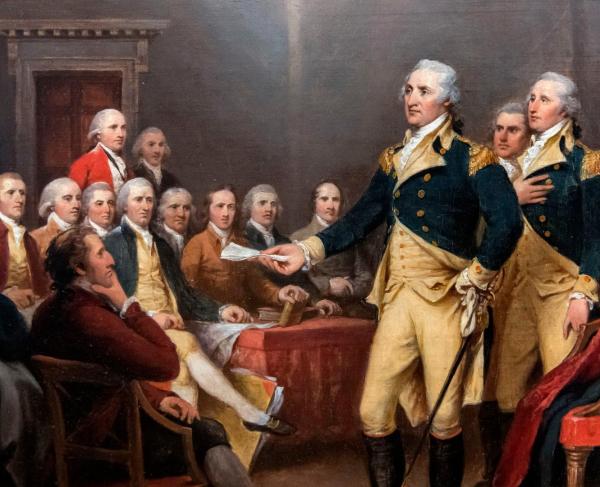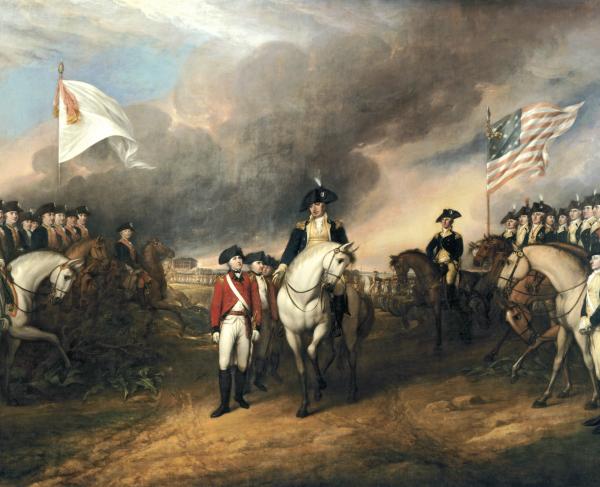On April 19, 1775, shots fired near the villages of Lexington and Concord brought war to the Massachusetts countryside and started the American Revolution. While Minute Men and militia companies rushed to respond to the advancing British column, women faced dangers and challenges on the new home front. The village greens, house yards and roads of their communities became the battlefield, and many numbered their loved ones among the militia and Minute Men. Many of the stories that exist about women’s actions on that historic day are not always clear in the history books and many legends exist; still, this points to women’s presence, even as the details are obscure or sometimes difficult to fully untangle.
For months prior to April 1775, Massachusetts communities had been resisting British authority—actively, passively and preparatorily. In Concord, local citizens signed a “Solemn League and Covenant” pledging not to buy British goods after August 31, 1774, to show their solidarity with Boston following the closing of the port and the Intolerable Acts. While men signed the document to represent their household, a few single women signed their own names, including two nieces of Colonel Barrett who was the local militia leader. Militia units drilled in preparation to defend the villages if British troops arrived to search for supplies or cached weapons. Women did not enlist in the militias, but they watched the units drill, observing the activities of their male relatives and friends. Organized Muster Days were often community events, and women may have attended to watch and socialize.
Married women or older daughters still living at home may have voiced support or concerns in private conversations, but these are mostly unknown and unrecorded. However, women would have been aware of the stakes as the men prepared for conflict if it became necessary. Historian Robert A. Gross described this reality poignantly in his book The Minutemen & Their World:
“But in March of ’75 the thirty-two-year-old Lucy [Hosmer] could only worry. Her husband, Joseph, was lieutenant of Concord’s troop of horse, and just as he had led the way in political opposition to Britain, he would surely be in the front lines of battle in the event of war. It was thus her conflict, too, whether she liked it or not…. Lucy was bound to follow her husband’s lead. Although she joined him in managing a household, she would seldom, if ever, be consulted on affairs of the world. Joseph would act on his own, and Lucy would run the risk of widowhood with four small children and a farm and shop to direct by herself.” (Page 98-99)
During the night of April 18-19, 1775, as messengers awakened the households in the communities along the roads to Concord, women likely helped their menfolk prepare to respond to the militia summons. Food and drink had to be packed so it could be easily taken while the men dressed and prepared their muskets and ammunition. Following the messengers' news, families had to decide what they would do if British soldiers reached their residence. Some women received direction or advice from the men rushing out the door, but others would make the decisions on their own for the safety of themselves and their children.
As the militias formed, hundreds of British soldiers marched into the communities, and volleys were fired at Lexington Green and Concord’s North Bridge, women responded in three notable ways: flee, resist or assist.
After her husband left their home in Lexington, Abigail Whitney gathered her six children and loaded them into a chaise wagon and started for Bedford, Massachusetts. At some point in their escape, a bullet sped through the side of the vehicle and narrowly missed the children. The Whitneys returned home later in the day.
Sarah Reed cradled her third baby in her arms. She had given birth about a couple weeks earlier but still had not fully recovered. According to family stories, Moses Reed did not join the gathering militia even though he was a member, but took Sarah, their children and her parents to hide in the woods.
Lydia Mulliken, a widow, hid her silver around her property, burying some in the yard and stashing the remainder in her well and shop. She then left home, seeking safety as the British approached. When she returned, she found her shop burned and much of the silver stolen.
According to a local story, Marcy Farrar who lived near Lincoln heard that the British soldiers were burning houses and preemptively left her home. She placed her baby son in a cradle along with the family’s Bible, silver spoons, and a mirror. Then, taking her toddler son and carrying the cradle, she hurried to the woods—anxiously watching to see if the soldiers burned the house.
While many women fled for safety before the British column arrived, some were forced to leave home. Hannah Adams had recently given birth to another baby. Her other children hid under her bed as British soldiers searched the house. A soldier thrust a bayonet toward her, and she was ordered to leave so they could burn the house. Hannah left, but her older children remained and extinguished the small fire after the soldiers departed.
Women’s resistance on April 19, 1775, evolved in various ways. Not all women left their homes, and as the British officers and soldiers arrived, interactions occurred. Aware that most of these women’s male relatives were likely in the militia opposing them, British soldiers did not scruple about searching homes, petty theft and insults. Some women stood on the thresholds of buildings or rooms and refused to let the British soldiers enter—frequently concealing militia supplies or valuable personal items from the home invasion.
An account survives of Rebecca Barrett (wife of Colonel James Barrett who commanded the local militia) who lived near Concord and whose farm was a hiding place for military weapons and supplies. British soldiers demanded food and drink after their march to Concord and offered to pay. Barrett refused to accept the money, saying, “We are commanded to feed our enemies”—quoting Scripture and making it clear how she felt about the British soldiers. Hurried and not in a mood to argue, the soldiers tossed the money toward her, and she responded, “This is the price of blood.”
In the village of Concord, Martha Moulton—a older widow who was employed as a housekeeper for Dr. Timothy Minot—begged British soldiers to put out the fire. They set some old artillery carriages aflame, and the blaze spread to the town meeting house and threatened a row of houses and the school. At first the British officers brushed offer her pleas, saying, “O, mother, we will not do you any harm! Do not be concerned, mother!” Finally, her persistence paid offer, and the officers ordered the soldiers to use buckets of water to extinguish the flames. but Martha's persistence proved successful when finally, "by one pail of water after another, they sent and did extinguish the fire."
Prudence Wright, who lived in Pepperell, took another active approach in her resistance. When the men of the village rallied and marched toward Lexington, she gathered the women who shouldered some remaining muskets and pitchforks and headed to nearby Jewett’s Bridge. There, the women captured a Loyalist carrying a message to the British in Boston.
Women also returned or stayed to assist. Sometimes, this meant cooking or handing out food or drink to the militia. They also tended to the wounded, which occasionally included British soldiers who had been left behind. Some women and their children also prepared cartridges so the militiamen would not run low on ammunition as they attacked the retreating British along what is now called Battle Road.
Some women also helped to spread the news about the British’s anticipated arrival or news of the battle. According to one story Mary Hartwell may have taken the news to a neighboring farmhouse. There are also stories about enslaved women—possibly named Victoria or Violet—who hurried to neighboring homes with alerts about the military action.
As April 19, 1775, came to an end and the sounds of battle faded toward Boston, the communities grappled with what had happened and how they would remember the day’s fight. Some women bent over wounded husbands, fathers, sons or brothers. Other women learned the tragic news that they were widowed. For example, Hannah Davis of Acton remembered her husband Isaac Davis leaving home that morning and pausing as if he “seemed to have something to communicate. He only said, ‘Take good care of the children,’ and was soon out of sight. In the afternoon, he was brought home a corpse”—one of the first men to fall at Concord’s North Bridge. Hannah Davis was a widow with four children.
Women responded individually and in different ways to the events of that historic day, April 19, 1775. Some hid in their homes while others refugeed away from the road and the fighting. Some spoke with British soldiers while others armed for a fight. Most mothers had the safety of their young children as a top priority that day. Some women took care of the wounded or returned home to find dead and injured soldiers in their houses. Whether they fled, resisted or assisted—or a combination of those actions—women were present as battle came passed or through their homes at the start of the American Revolution.
Further Reading:
- The Minutemen and Their World by Robert A. Gross (Hill and Wang; First Edition, 25th Anniversary Edition, 2001.)
- American Spring: Lexington, Concord, and the Road to Revolution by Walter Borneman (Back Bay Books, 2015)
- Liberty's Daughters: The Revolutionary Experience of American Women, 1750–1800 by Mary Beth Norton (Cornell University Press, 1996)
- The British Are Coming by Rick Atkinson (Henry Holt and Co., 2019)
Related Battles
93
300


